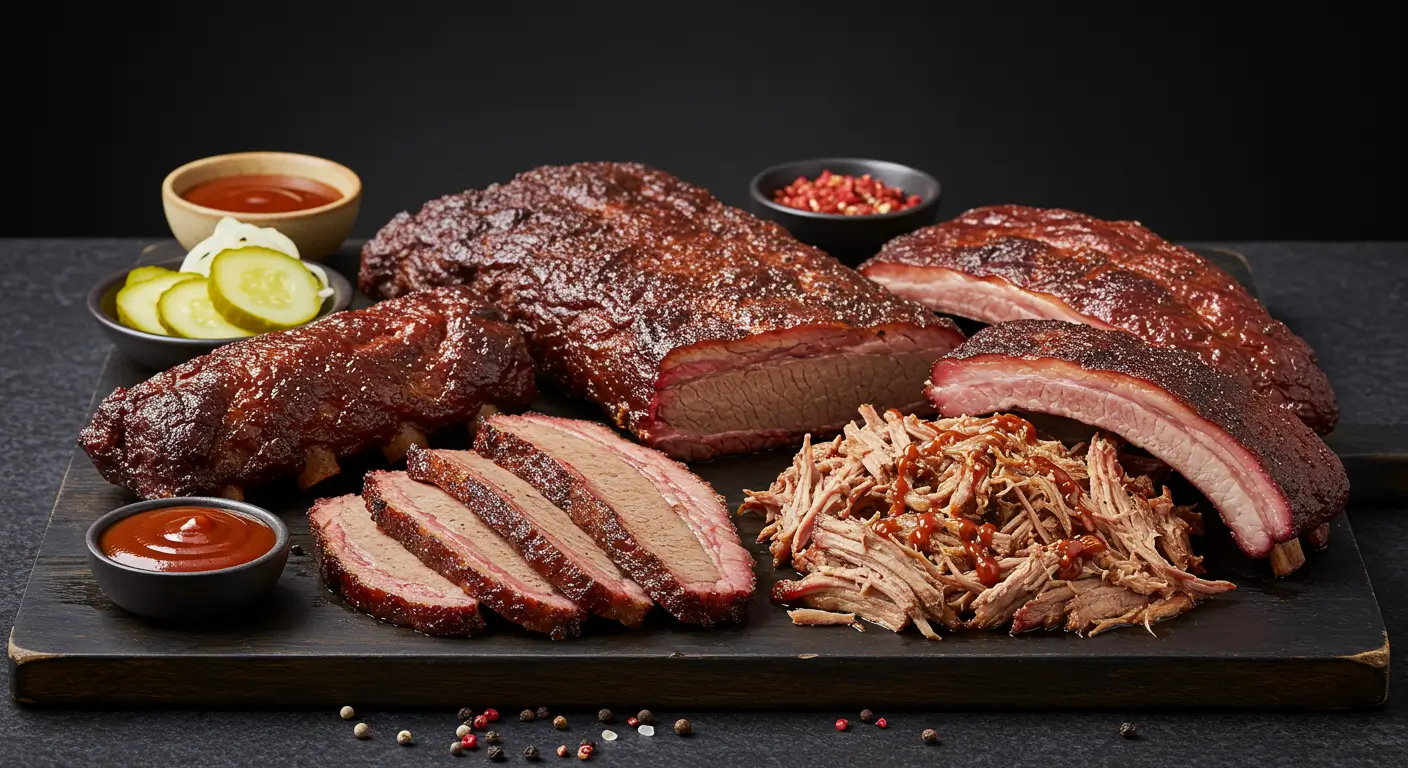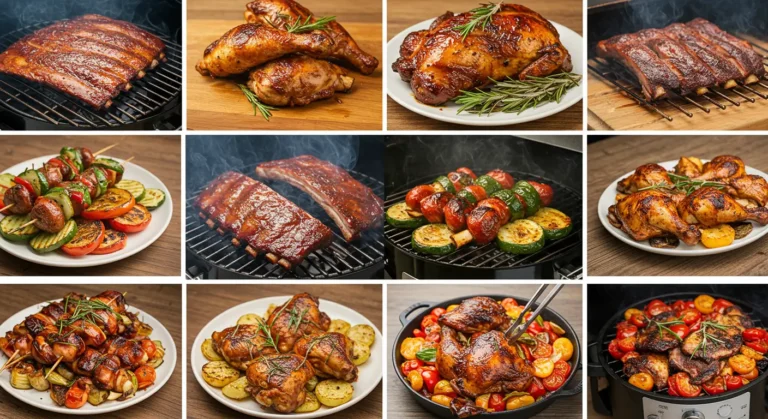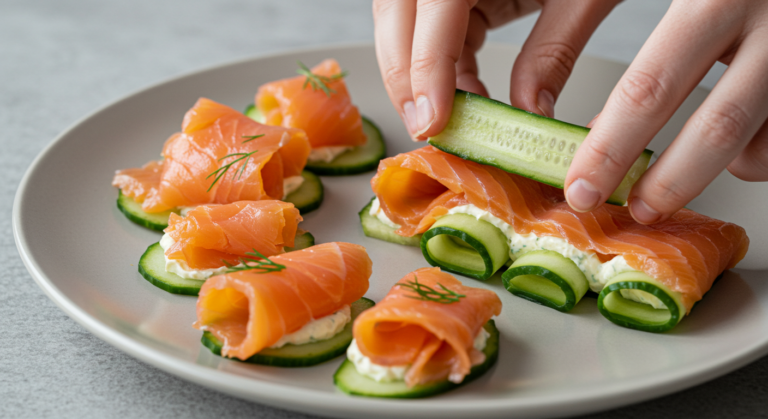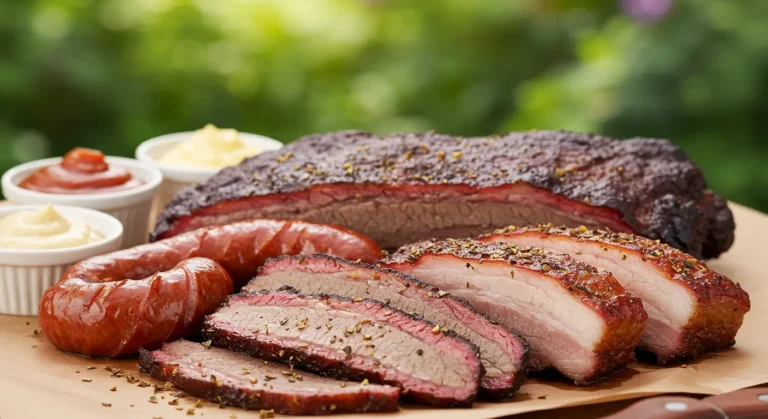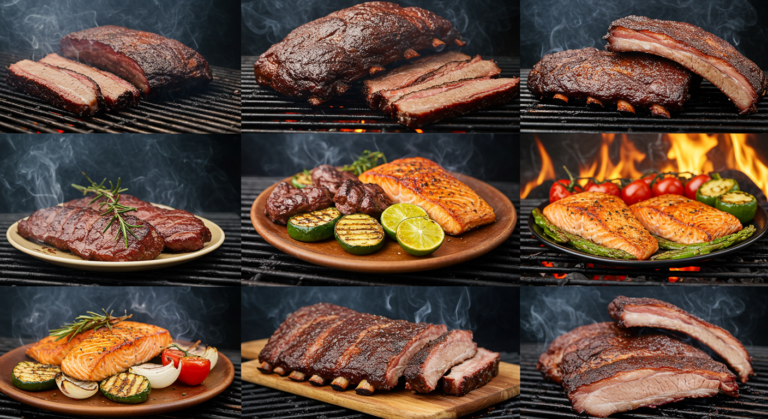Best Meats to Smoke: The Ultimate Guide for Beginners and Enthusiasts
There’s something almost magical about the first time you lift the lid on your smoker to reveal a perfectly cooked brisket, its exterior dark and crusty, the meat beneath tender enough to pull apart with your fingers. That distinctive ring of pink just beneath the surface isn’t just visually appealing—it’s a badge of honor, proof that you’ve mastered one of cooking’s most rewarding techniques.
Welcome to the world of smoked meats, where patience is rewarded with flavors you simply can’t achieve through any other cooking method. Whether you’re firing up your smoker for the first time or looking to expand your repertoire of smoke-kissed creations, this guide will walk you through everything you need to know about selecting the best meats to smoke, techniques to perfect your craft, and recipes that will have your friends and family lining up for seconds.
What Makes Smoking Different from Other Cooking Methods?
Before diving into specific cuts and recipes, let’s understand what makes smoking such a unique cooking technique.
“Smoking isn’t just cooking—it’s a transformation,” says championship pitmaster Aaron Franklin. “You’re not just applying heat; you’re infusing food with complex flavors that develop and change over hours.”
Unlike grilling or roasting, smoking involves cooking food at lower temperatures (typically 225-275°F) for extended periods while exposing it to wood smoke. This slow process accomplishes two things: it breaks down tough connective tissues in meat, creating tenderness, while simultaneously infusing everything with that distinctive smoky flavor.
The Art and Science of Smoking Food
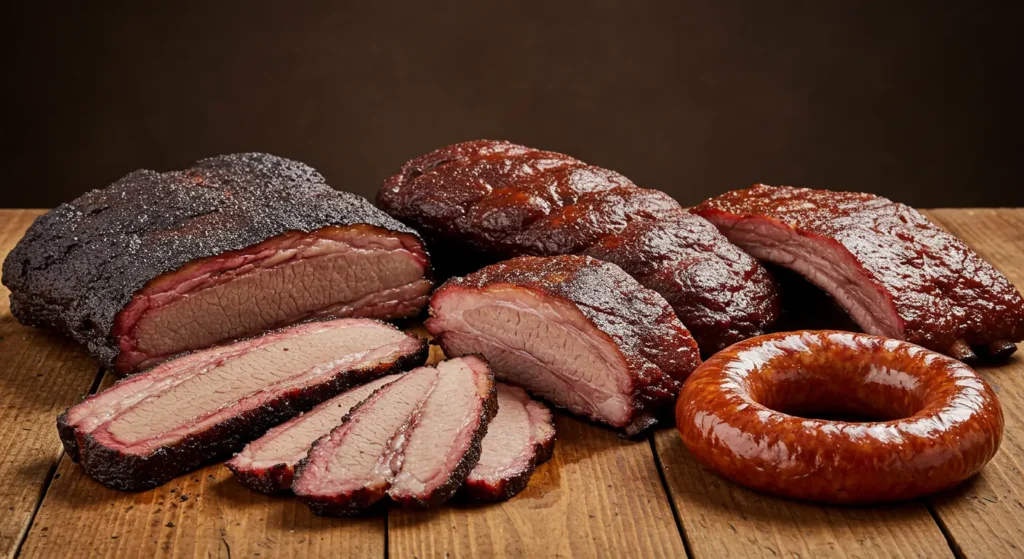
Understanding the Smoking Process
Smoking is as much science as it is art. When you cook meat low and slow, the collagen and connective tissues gradually break down into gelatin, creating that melt-in-your-mouth texture that’s impossible to achieve with high-heat cooking. Meanwhile, compounds in the smoke adhere to the food’s surface, creating that characteristic flavor and the prized “smoke ring.”
Wood Matters: Choosing the Right Flavor Profile
The type of wood you use significantly impacts your final results:
- Hickory: Strong and bacony—perfect for beef and pork when you want pronounced smoke flavor
- Apple: Mild and slightly sweet—excellent for chicken and pork
- Mesquite: Intense and earthy—great for beef, particularly in Texas-style barbecue
- Cherry: Mild with a hint of sweetness—a versatile choice that creates a beautiful mahogany color
- Oak: Medium strength and versatile—the workhorse of smoking woods that pairs well with everything
- Pecan: Sweet and nutty—wonderful with poultry and pork
“Wood selection isn’t just about flavor,” explains Myron Mixon, four-time world barbecue champion. “It’s about creating balance. Your smoke should complement the meat, not overpower it.”
Temperature Control: The Key to Success
Maintaining consistent temperature is crucial in smoking. The ideal range of 225-275°F allows for proper rendering of fat while keeping the meat moist. Too hot, and you’ll end up with dry meat; too cool, and you risk food safety issues.
Many smokers struggle with “the stall”—a phenomenon where the internal temperature of larger cuts like brisket or pork shoulder plateaus for hours, typically around 150-170°F. This happens as moisture evaporates from the meat’s surface, creating a cooling effect. Experienced pitmasters either wait it out (sometimes for several hours) or use the “Texas crutch” method of wrapping the meat in butcher paper or foil to push through this phase.
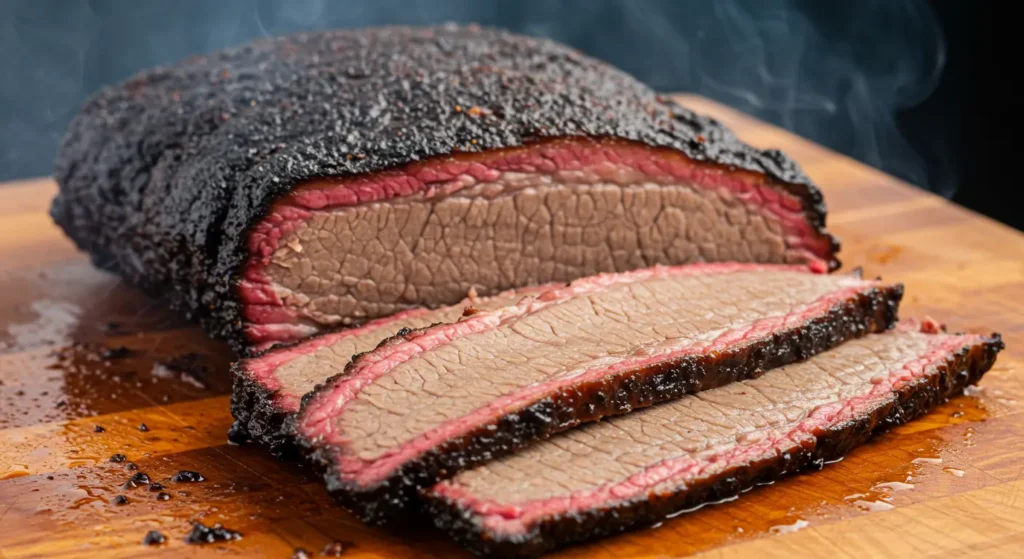
What Are the Best Types of Smokers?
Different smokers offer unique advantages, and the “best” type depends on your personal preferences:
Offset Smokers: These horizontal chambers with a firebox attached to the side are traditional favorites among purists. They require the most attention but offer excellent control once mastered.
Electric Smokers: Perfect for beginners, these plug-in options maintain consistent temperatures with minimal monitoring, though some enthusiasts feel they lack the authentic character of other methods.
Pellet Smokers: These modern favorites offer push-button convenience and consistent results, automatically feeding wood pellets to maintain your chosen temperature.
Kettle Grills: Standard charcoal grills can be adapted for smoking, making them versatile and budget-friendly starting points.
Ceramic Kamado Smokers: These egg-shaped cookers offer excellent insulation and temperature stability, perfect for long smoking sessions in any weather.
Propane Smokers: These combine the convenience of gas with traditional smoking techniques for a user-friendly experience.
Drum Smokers: Simple, efficient, and often homemade, these vertical smokers have gained popularity for their straightforward design and consistent results.
What Are the Best Meats to Smoke?
Beef: The King of Smoke
Brisket: Often considered the holy grail of smoking, this tough cut transforms into tender, flavorful meat after 10-16 hours in the smoker. Choose a whole packer brisket (both the point and flat muscles) with good marbling for best results. Pair with oak or hickory.
Beef Ribs: These impressive dinosaur-sized bones deliver intense beefy flavor and fall-off-the-bone tenderness after 6-8 hours of smoking. Mesquite or oak provide ideal complements to the rich meat.
Chuck Roast: The poor man’s brisket, this affordable cut responds beautifully to smoking and pulls apart into delicious shredded beef after 6-8 hours. Hickory adds wonderful depth.
Prime Rib: For special occasions, nothing beats a smoke-kissed prime rib. Smoke at slightly higher temperatures (275°F) until reaching your preferred doneness, usually 4-6 hours. Oak or cherry wood provide subtle enhancement without overwhelming the premium meat.

Pork: Versatile and Forgiving
Pork Shoulder/Boston Butt: The cornerstone of pulled pork, this forgiving cut can smoke for 10-14 hours until it reaches an internal temperature of 195-205°F. Apple, hickory, or cherry wood pairs beautifully.
Ribs: Whether you prefer baby backs or St. Louis-style, pork ribs are smoker favorites. They typically require 4-6 hours and pair with almost any smoking wood, though apple and cherry are particularly popular.
Pork Belly: The same cut that gives us bacon becomes meltingly tender after 5-6 hours in the smoker. Many pitmasters cure it first, then smoke with maple or apple wood for complementary sweetness.
Ham: Starting with a fresh (uncured) ham and smoking it yourself creates a showcase piece unlike anything from the grocery store. Depending on size, smoking takes 6-10 hours with mild woods like apple or cherry.
Poultry: Quick and Crowd-Pleasing
Whole Chicken: Perfect for beginners, a whole chicken smokes in just 2-3 hours. Brine it first for juicier meat, and consider spatchcocking (butterflying) to reduce cooking time and ensure even results. Light woods like apple or cherry prevent overpowering the delicate meat.
Turkey: Whether for Thanksgiving or any special occasion, smoked turkey offers wonderful flavor. Allow 30-40 minutes per pound, typically 3-5 hours for a standard bird. Pecan and apple wood provide complementary flavors.
Chicken Wings: These crowd-pleasers smoke in just 1.5-2 hours and absorb flavor beautifully. Try oak or hickory for more robust flavor than you’d typically use with poultry.
Duck: The high fat content makes duck perfect for smoking. Allow 2-3 hours for a whole duck, paired with fruit woods like cherry or apple to balance the richness.
Game Meats: Adventure in Smoking
Venison: Lean and flavorful, venison shoulders or roasts benefit from the moisture-preserving environment of a smoker. Smoke for 3-4 hours with hickory or mesquite.
Wild Boar: Similar to pork but leaner, wild boar shoulders or hams smoke beautifully for 8-12 hours. Cherry and apple woods complement without overwhelming.
Lamb: Whether it’s a whole leg or shoulder, lamb develops wonderful flavor when smoked for 4-6 hours. Stronger woods like hickory stand up well to lamb’s distinctive character.
Beyond Meat: Yes, You Can Smoke Nearly Anything!
Seafood Smoking
Fish and seafood require different approaches than traditional barbecue:
Salmon: Cold-smoke below 80°F for delicate texture, or hot-smoke at 225°F for about 1-2 hours until it reaches 145°F internally. Alder wood is traditional, though maple adds nice sweetness.
Trout: These smaller fish smoke quickly, usually in 1-2 hours at 225°F. Alder or apple wood works beautifully.
Oysters: Smoke shucked oysters for just 30-45 minutes for a unique appetizer. Use very mild woods like alder.
Vegetable Smoking
Vegetables absorb smoke flavors remarkably well:
Corn: Smoke in the husk for 1-1.5 hours for a wonderful side dish.
Peppers: Bell peppers, jalapeños, and poblanos transform after 1-2 hours in the smoker.
Mushrooms: Portobello and oyster mushrooms develop meaty, complex flavors after 1-2 hours of smoking.
Tomatoes: Smoke halved tomatoes for 2 hours to create incredible bases for sauces and soups.
Unexpected Items: Try smoking butter, salt, or even ice for cocktails to add subtle smokiness to various dishes.
Beginner-Friendly Smoking Recipes
If you’re new to smoking, these approachable recipes help build confidence:
Smoked Chicken Quarters
Ingredients:
- 4 chicken leg quarters
- 2 tablespoons olive oil
- 3 tablespoons poultry rub (store-bought or homemade with paprika, salt, garlic powder, onion powder, and black pepper)
Instructions:
- Rub chicken with oil, then thoroughly coat with seasoning
- Smoke at 275°F using apple wood
- Cook until internal temperature reaches 175°F (about 1.5-2 hours)
- No need to flip during cooking
- Rest for 10 minutes before serving
Pro Tip: Chicken skin can become rubbery in the smoker. For crispy skin, finish on a hot grill for 1-2 minutes per side.
Simple Smoked Pork Loin
Ingredients:
- 3-4 pound pork loin (not tenderloin)
- 2 tablespoons mustard
- 3 tablespoons all-purpose rub
Instructions:
- Coat pork with mustard as a binder, then apply rub generously
- Smoke at 250°F using cherry wood
- Cook until internal temperature reaches 145°F (about 2.5-3 hours)
- Rest for 15 minutes before slicing
Pro Tip: “Pork loin is lean, so don’t overcook it,” warns pitmaster Tuffy Stone. “Pull it at exactly 145°F for perfect juiciness.”
Advanced Smoking Recipes
Ready for a challenge? These show-stoppers will test your skills:
Competition-Style Smoked Brisket
Ingredients:
- 12-14 pound whole packer brisket
- 1/2 cup coarse kosher salt
- 1/2 cup coarse black pepper
- 1/4 cup garlic powder (optional)
- Butcher paper for wrapping
Instructions:
- Trim excess fat, leaving 1/4 inch fat cap
- Season generously with salt, pepper, and garlic powder if using
- Let sit at room temperature for 1 hour
- Smoke at 250°F using oak wood
- When internal temperature reaches 165-170°F (usually 6-8 hours in), wrap tightly in butcher paper
- Continue smoking until internal temperature reaches 203°F (another 4-6 hours)
- Rest wrapped in a cooler for at least 1 hour, preferably 2-3 hours
- Slice against the grain when serving
Pro Tip: The brisket is done when a temperature probe slides in “like butter,” not just when it hits a certain temperature.
Smoked Beef Short Ribs
Ingredients:
- 4-5 pounds beef short ribs (plate ribs preferred)
- 2 tablespoons coarse salt
- 2 tablespoons coarse black pepper
- 1 tablespoon garlic powder
Instructions:
- Remove silverskin membrane from bone side
- Season generously on all sides
- Smoke at 275°F using hickory or oak
- Cook until internal temperature reaches 205°F (about 6-8 hours)
- Ribs are done when a toothpick slides in with no resistance
- Rest 30 minutes before serving
Pro Tip: Spray with beef broth every hour after the first three hours to maintain moisture.
Creating Your Own Rubs and Sauces
Every pitmaster eventually develops their signature flavors:
Basic BBQ Rub Formula
- 4 parts salt
- 3 parts sugar (brown or white)
- 2 parts paprika
- 1 part garlic powder
- 1 part onion powder
- 1 part black pepper
- Add chili powder, cumin, or cayenne to taste
Simple Mop Sauce
- 1 cup apple cider vinegar
- 1 cup apple juice
- 2 tablespoons Worcestershire sauce
- 1 tablespoon your BBQ rub
Troubleshooting Common Smoking Problems
Even experienced pitmasters encounter challenges:
Tough Results: If meat is tough, it likely needs more time. Most barbecue cuts need to reach 195-205°F to fully render collagen.
Dry Meat: Could be from too high temperatures or cooking past ideal temperature. Remember different meats have different target temperatures.
Too Much Smoke Flavor: Use less wood or switch to milder varieties. Remember that thin blue smoke is ideal—thick white smoke creates bitter flavors.
Temperature Fluctuations: Most often caused by improper fire management or smoker leaks. Consider gasket seals for your smoker doors.
Conclusion: Finding Your Smoking Style
The beauty of smoking meat lies in the journey as much as the destination. Each session teaches you something new, refining your technique and developing your personal style. Whether you’re drawn to Texas-style simplicity with salt and pepper, Carolina whole-hog traditions, or innovative fusion approaches, there’s always something new to explore.
Remember that the best BBQ often comes from understanding fundamentals, then making them your own. Start with the classic cuts recommended here, master their basics, then begin experimenting with your own techniques and flavor profiles.
Most importantly, share your creations. BBQ has always been about community—bringing people together around exceptional food created through passion and patience.
Frequently Asked Questions
Have You Tried This Recipes!
There are no reviews yet. Be the first one to write one.

